![]() On 27 January 1998 the commission issued a directive that requires energy labels for household lamps.
On 27 January 1998 the commission issued a directive that requires energy labels for household lamps.
In this article the main items from the directive are mentioned and the energy label itself is shown. OliNo will add these into the new lamp measurement articles.
On request this label can be added to already existing articles at a small cost.
Update 9 Nov 2010: on request a graph is added that indicates the performance of the lamp in a Lumen-Watt field. This is a visual indication of in what classification the lamp falls and how well within that classification it is positioned.
Update 11 May 2013: an update has been done on the labels, see also this article.
Commission Directive 98/11/EG
This commission directive informs about the items below.
For which lamps this directive is meant
(or not meant)
What kind of information is on the label
This label needs to contain:
– the luminous flux in Lumen
– the consumed power in Watt
– the classification. This is determined from the luminous flux and the consumed power. Class A is more efficient and class G the least efficient. A difference in calculation is made between fluorescent lamps without integral ballast and all other lamps.
– the lifetime in hours (not needed when there is no other information on the life of the lamp in the catalogue)
The amount of light coming from a lamp is given in lumen and not in Watt. The link to Watt cannot be made anymore since the banning of incandescent light bulbs. With the new light bulb technologies with their own efficacies the number of Watt does not link anymore to the amount of light produced.
Herewith a table with the amount of lumen for well known incandescent lamps of different power.
Indications of the minimum luminous flux for incandescent lamps of certain power.
So an incandescent of 25 W would deliver at least 250 lumen for luminous flux, etc.
The 30-70-100 are three way lamps, having two separate filaments that can be driver separately of together, hence the link with three powers.
Addition per 30 Nov 2010: IEC 60064, Ed. 6.0 2009-07 is an “international standard” about “Thungsten filament lamps for domestic and similar lighting purposes – performance requirements”. This indicates the following minimum luminous fluxes (PHI) for thungsten filament lamps (E27 and B27 fitting types, with clear or frosted bulb) at 230 V. Often values are given for both high PHI and low PHI.
| P [W] | PHI_low [lm] | PHI_high [lm] |
|---|---|---|
| 15 W | 110 | – |
| 25 W | 220 | 230 |
| 40 W | 345 | 415 |
| 60 W | 620 | 710 |
| 75 W | 935 | – |
| 100 W | 1240 | 1340 |
| 150 W | 2070 | 2160 |
| 200 W | 2900 | 3040 |
The definition of the label
See the directive. In it the dimensions are font types and colors are given that should be used. Below the labels in color, including the lifetime information.
Also labels are made without the “h”, so without the indication of the life of the lamp.
There are also labels in black and white. These are also presented in the lamp measurement articles.
Some specific items on the data
The information on the life of the lamp can be omitted when there is no other information on the life of the lamp in the catalogue. When OliNo has determined the life of the lamp then this can be indicated on the label.
In the data on the label OliNo will round the lumen total to 5 lumen. This is not explicitly requested in the directive, but follows the American example for lamp labels (“new labels on light bulb packaging“). See below for an example:
Lamp label for lamp packages (USA).
The lamp’s performance in the Lumen-Watt field
Herewith an image to visualize the lamp’s performance in the Lumen-Watt field. The image indicates the areas A until and including F (G is above F) and the position of Lumen-Watt of the lamp. It becomes clear whether the lamp is close to a classification border or not for instance.
This image will be given for new lamp measurement articles. The x and Y axes are adjusted to have good visibility of the lamp performance point. The areas are automatically adjusted to the type pf lamp. There are two types: the fluorescent without driver and all other lamps. The first one has more severe requirements on the area of class A.
Visualization of the lamp’s performance in the energy performance area of Lumen and Watt
The colors used for the different areas A to G are the same as in the label itself.
Template Lumen-Watt fields
For convenience herewith the images that show the energy efficacy fields A to G for 0-6500 Lm and one zoomed in on 0-500 Lm.
When Lm and W are known of a lamp, then this can be used to find out visually in what energy efficicacy class the lamp falls.
Fluorescent lamps without integrated ballast / power supply
Lumen-Watt field for fluorescent lamps without integrated ballast (or power supply)
Lumen-Watt field for fluorescent lamps without integrated ballast (or power supply), zoomed 0-500 lm.
All other lamps
Lumen-Watt field for all other lamps.
Lumen-Watt field for all other lamps, zoomed 0-500 lm.
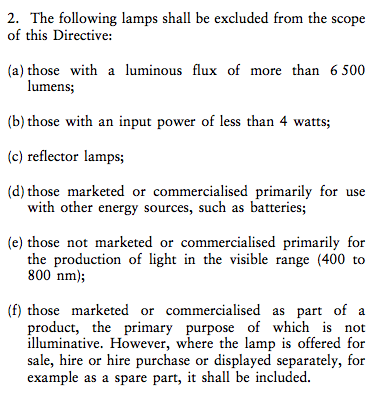
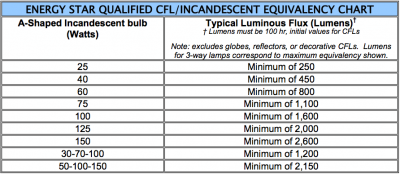

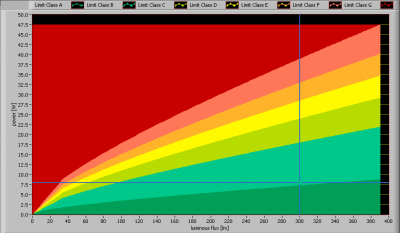
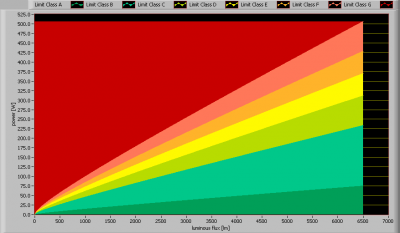
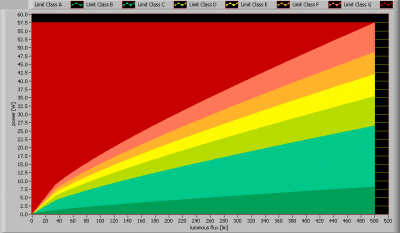
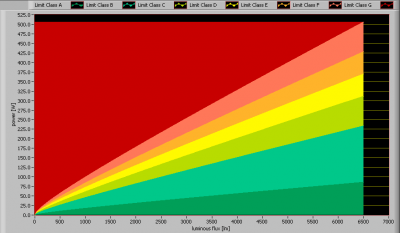
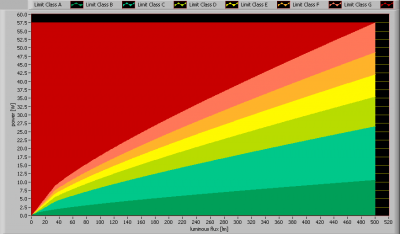





2 replies on “EU Energy label for lamps”
Dear Sir/ Madam,
How are you doing? This is Mr. Desmond Ng from GT BiomeScilt light. I would like to apply EU Energy label where to add on our LED lighting products packaging.
Can you advice how can i apply to entitle the label?
– what is requirement to get EU Energy label? Any Test report should be done?
– What is the Price for EU Energy label?
I need to know asap, hope can hear from you soon.
Cheers,
Desmond Ng
Business Development Manager
Hi Desmond,
EU energy label is compulsory when you put your products on EU market. You can use the labels we make as part of standard measurement. For standard measurement you have fast track option (450 euro at time of writing, results within one week) and bonus option (bonus 300 euro, so finally paying 150 euro, results within 4 weeks and obligation to publish results).
You can contact me for more info. See http://www.olino.org/us/contributors/marcel-van-der-steen